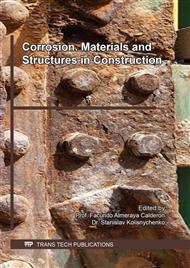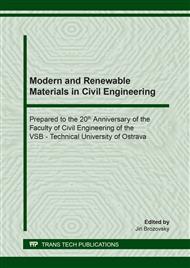p.3
p.11
p.21
p.29
p.41
p.51
p.63
p.73
Determination of Time Dependent Diffusion Coefficient Aging Factor of HPC Mixtures
Abstract:
This study investigates computation and distribution of the diffusion coefficient using fundamentals of electrochemistry for various concrete mixtures. The instrument utilized is a bulk conductivity meter which provides the bulk conductivity data for computation of the diffusion coefficient. Thirty three mixtures are investigated, where majority of them are ternary mixtures along with Ordinary Portland Cement (OPC) and binary mixtures. They are categorized in several groups based on the supplementary cementitious material (SCM) as a second component in ternary and binary based concrete mixtures. The variation and distribution of the diffusion coefficient in individual group is investigated from 7 days to 161 days. In addition, a new methodology is proposed to determine the aging factor of the diffusion coefficient of each concrete mixture. Aging of concrete is related to chloride ingress which leads to significant decrease of the diffusion coefficient with time. If this effect is not taken into account, considerable questions can be raised while predicting reliable and accurate service life of reinforced concrete structures. Further, aging factor is validated using a statistical analysis method based on published literature of Fisher Test permutation approach. Results show that diffusion coefficient in each group varies significantly and the addition of SCM and its varying replacement level influences the reduction of the diffusion coefficient remarkably over extended time period. Overall, this study could provide promising options for computation of the diffusion coefficient and its aging factor in light to its ease of measurement and shorter amount of time than conventional RCPT and other long term migration tests.
Info:
Periodical:
Pages:
11-20
Citation:
Online since:
February 2020
Authors:
Price:
Сopyright:
© 2020 Trans Tech Publications Ltd. All Rights Reserved
Share:
Citation:



